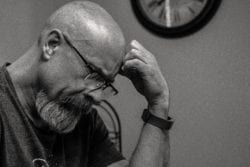 There is hair, of varying thickness, growing everywhere on your skin except on the palms of your hands and the soles of your feet. Some of the hairs are so fine as to be almost invisible but they are there. Hair is composed of a protein called keratin that your hair follicles in the outer layer of skin produce. As your follicles create new hair cells, the old cells are pushed out through the surface of the skin at the rate of about six inches a year in the form of hair. The hairs we see are actually strings of dead keratin cells. The average adult human head has about 100,000 to 150,000 hairs. We naturally lose up to 100 hairs a day so finding a few stray hairs on your hairbrush or comb does not necessarily mean you are having a a hair loss problem.
There is hair, of varying thickness, growing everywhere on your skin except on the palms of your hands and the soles of your feet. Some of the hairs are so fine as to be almost invisible but they are there. Hair is composed of a protein called keratin that your hair follicles in the outer layer of skin produce. As your follicles create new hair cells, the old cells are pushed out through the surface of the skin at the rate of about six inches a year in the form of hair. The hairs we see are actually strings of dead keratin cells. The average adult human head has about 100,000 to 150,000 hairs. We naturally lose up to 100 hairs a day so finding a few stray hairs on your hairbrush or comb does not necessarily mean you are having a a hair loss problem.
Hair Loss Types
At any given time, about 90% of the hair on your scalp is growing. Each hair follicle has its’ own life cycle that can be influenced by age, disease, and a variety of other factors. As you age, your rate of hair growth slows and hair loss, also called alopecia, may begin. There are many types of alopecia. The most common types are:
- Involutional alopecia is a natural condition wherein the hair gradually thins with age. Your hair follicles enter the resting phase, and the remaining hairs become shorter and fewer in number.
- Androgenic alopecia is a genetic condition that affects both men and women. Men suffering from this condition, commonly called male pattern baldness, can begin suffering hair loss as early as their teens or early twenties. It commonly manifests with a receding hairline and gradual disappearance of hair from the crown and frontal scalp. Women with this condition, called female pattern baldness, don’t usually experience noticeable thinning until their forties or later. Women tend to experience a general thinning over the entire scalp, with the most extensive hair loss at the crown.
- Alopecia areata can start suddenly and cause patchy hair loss in children and young adults. This condition can result in complete baldness (alopecia totalis) but the hair usually returns within a few years for 90% of those afflicted.
- Alopecia universalis causes all body hair to fall out, including the eyebrows, eyelashes, and pubic hair.
- Trichotillomania, a condition seen most frequently in children, is a psychological disorder in which a person pulls out one’s own hair.
- Telogen effluvium is temporary hair thinning over the scalp that can occur due to changes in the growth cycle of hair. If a large number of hairs enter the resting phase at the same time, shedding and subsequent thinning can result.
- Scarring alopecias cause permanent loss of hair. Inflammatory skin conditions (cellulitis, folliculitis, severe acne), and other skin disorders (such as some forms of lupus and lichen planus) often result in scars that destroy the ability of the hair follicles to regrow hair. Hot combs and hair too tightly woven and pulled can sometimes bring about permanent hair loss as well.
Hair Restoration Philadelphia
Whatever the reason behind your hair loss, a consultation with Dr. Goldfarb at Hair Restoration Philadelphia can determine if hair restoration is right for you and what method would most benefit you. Hair loss can be damaging to your self-confidence. Restore your hair and strengthen your self-image with hair restoration treatment. Hair Restoration Philadelphia has three convenient locations in the Philadelphia area. We offer the FUE and PRP methods of hair restoration. To schedule a consultation, call 215.352.5254 or request an appointment online.
